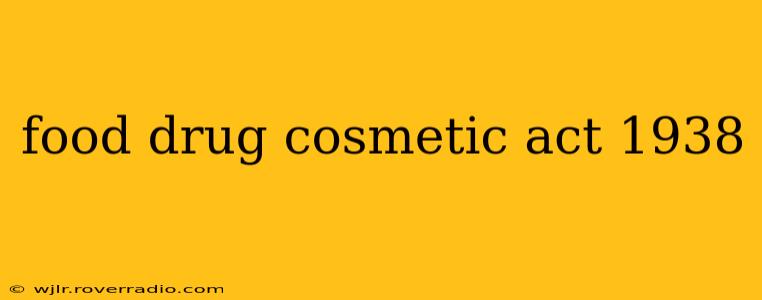The Food, Drug, and Cosmetic Act of 1938 (FD&C Act) stands as a cornerstone of American public health legislation. Passed in the wake of several tragic incidents highlighting the dangers of unregulated food and drug products, this act significantly reformed the nation's approach to consumer safety. It's not just a historical artifact; its influence continues to shape modern food and drug regulations. This comprehensive guide will explore the key provisions of the FD&C Act, its impact, and its lasting legacy.
What Prompted the Need for the Food, Drug, and Cosmetic Act of 1938?
The impetus for the FD&C Act stemmed from a series of devastating events that exposed significant gaps in existing consumer protection laws. Most notably, the tragic deaths of over 100 people from consuming Elixir Sulfanilamide, a medicine containing a toxic solvent, galvanized public outrage and fueled the demand for stronger regulations. This tragedy, alongside other incidents involving contaminated food and misleading drug claims, propelled the need for comprehensive reform. Prior to 1938, the existing 1906 Pure Food and Drugs Act lacked sufficient enforcement mechanisms and failed to adequately address cosmetic safety.
What are the Key Provisions of the Food, Drug, and Cosmetic Act of 1938?
The FD&C Act introduced several landmark provisions that fundamentally changed the landscape of food and drug regulation:
-
Pre-market approval of new drugs: This crucial provision required drug manufacturers to demonstrate the safety of their products before they could be marketed to the public. This marked a significant shift from the previous system, where the onus of proving harm rested on the consumer.
-
Safety standards for cosmetics and food: The Act established standards for the safety of cosmetics and food products, addressing concerns about contamination and harmful ingredients. This included provisions for proper labeling and manufacturing practices.
-
Enhanced enforcement powers: The FD&C Act provided the Food and Drug Administration (FDA) with significantly stronger enforcement powers, allowing them to conduct inspections, issue recalls, and levy penalties against violators.
-
Accurate labeling requirements: This provision ensured that food, drug, and cosmetic labels accurately reflect the product's contents and intended use, preventing misleading claims and protecting consumers from deception.
-
Tolerances for pesticide residues: The act provided for the establishment of acceptable limits for pesticide residues in food, balancing the benefits of pest control with the need to protect public health.
How Does the Food, Drug, and Cosmetic Act of 1938 Impact Consumers Today?
The enduring legacy of the FD&C Act is evident in the safety and quality of food, drugs, and cosmetics available to consumers today. The act laid the groundwork for a robust regulatory system that safeguards public health by:
-
Ensuring the safety of medications: The pre-market approval process helps prevent the introduction of dangerous drugs, protecting millions from potential harm.
-
Promoting accurate product labeling: Clear and accurate labeling allows consumers to make informed choices about the products they use and consume.
-
Protecting against contaminated food: Stringent food safety regulations help minimize the risk of foodborne illnesses and ensure a safer food supply.
-
Regulating the cosmetic industry: Safety standards for cosmetics help protect consumers from potentially harmful ingredients.
What are the Differences Between the 1906 Pure Food and Drug Act and the 1938 FD&C Act?
The 1906 Pure Food and Drugs Act primarily focused on preventing adulteration and misbranding. It lacked the pre-market approval process for new drugs and lacked the power to effectively address the safety of cosmetics. The 1938 FD&C Act addressed these shortcomings, providing a more comprehensive and robust regulatory framework. The 1938 act shifted the burden of proof regarding safety from the consumer to the manufacturer, a crucial change that significantly improved consumer protection.
What are some common misconceptions about the Food, Drug, and Cosmetic Act of 1938?
A common misconception is that the FD&C Act completely eliminates the risk of unsafe products. While the act significantly reduces risk, it's crucial to remember that no regulatory system is perfect. New challenges, such as the rise of novel food technologies and the emergence of new diseases, continue to test the adaptability of the regulatory framework.
How has the Food, Drug, and Cosmetic Act of 1938 evolved over time?
The FD&C Act has undergone numerous amendments and expansions since 1938, reflecting the ever-evolving scientific understanding and technological advancements in the food, drug, and cosmetic industries. These amendments have addressed issues such as the regulation of medical devices, dietary supplements, and genetically modified foods, ensuring the act remains relevant and effective in protecting public health.
The Food, Drug, and Cosmetic Act of 1938 represents a watershed moment in consumer protection. Its impact extends far beyond its initial legislative intent, shaping the safety and quality of the products we consume and use every day. The Act’s continuous evolution underscores its importance as a dynamic and adaptable framework for safeguarding public health in an ever-changing world.
